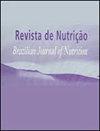Association between maternal dietary intake classified according to its degree of processing and sex-specific birth weight for gestational age
IF 0.5
4区 医学
Q4 NUTRITION & DIETETICS
Revista De Nutricao-brazilian Journal of Nutrition
Pub Date : 2022-01-01
DOI:10.1590/1678-9865202235e210197
引用次数: 0
Abstract
ABSTRACT Objective To assess the association between the maternal diet, according to the degree of processing of food consumption, and birth weight for gestational age and sex. Methods A cross-sectional study with 300 women was conducted from February 2009 to 2011 from a maternity ward in Mesquita, Rio de Janeiro. The outcome was based on sex-specific birth weight for gestational age: small, adequate, or large. A validated food frequency questionnaire was used to estimate the food consumption during the 2nd and 3rd trimesters of pregnancy. The food intake was classified into three groups according to the degree of processing: 1) unprocessed or minimally processed foods and culinary ingredients (oil, fats, salt, and sugar), 2) processed foods, and 3) ultra-processed foods. Descriptive analyses were made to assess the tertiles of the percentage of energy intake of each food group on the outcome and on maternal and infant characteristics. Multinomial logistic regressions were used to test the association of the tertiles of food according to the degree of processing on the outcome (adequate, small, or large birth weight for gestational age and sex). Results The analysis of the food frequency questionnaire from the 300 women indicated that the mean percentage of kcal consumed from unprocessed and minimally processed food and culinary ingredients was 54.0%, while the percentages of energy from processed foods and ultra-processed foods were 2.0% and 44.0%, respectively. The highest tertile of consumption of unprocessed and minimally processed food and culinary ingredients had a protective effect on the prevalence of newborn large for gestational weight in relation to the lowest (OR: 0.13; 95% IC: 0.02 to 0.89; p=0.04). Conclusion High consumption of unprocessed and minimally processed food and culinary ingredients during the last six months of pregnancy might be a protective factor against having a newborn large for gestational weight when compared to mothers with the lowest consumption.根据加工程度分类的产妇膳食摄入量与胎龄性别特异性出生体重之间的关系
【摘要】目的探讨孕妇饮食加工程度与胎龄、性别新生儿出生体重的关系。方法对2009年2月至2011年2月在巴西里约热内卢梅斯基塔市产科病房就诊的300名妇女进行横断面研究。结果是基于胎龄的性别特异性出生体重:小、足或大。使用一份有效的食物频率问卷来估计怀孕第二和第三个月的食物消耗。根据加工程度将食物摄入量分为三组:1)未加工或最少加工的食物和烹饪原料(油、脂肪、盐和糖),2)加工食品,3)超加工食品。进行描述性分析,以评估每组食物的能量摄入百分比对结果和母婴特征的影响。使用多项逻辑回归来检验根据加工程度对结果(胎龄和性别的出生体重足够、小或大)的食物成分之间的关联。结果对300名女性食物频率问卷的分析表明,未加工食品、最低加工食品和烹饪配料的平均卡路里消耗比例为54.0%,加工食品和超加工食品的能量消耗比例分别为2.0%和44.0%。食用未加工食品和最低加工食品及烹饪原料的最高比例对新生儿超重的发生率有保护作用,相对于最低比例(OR: 0.13;95% IC: 0.02 ~ 0.89;p = 0.04)。结论孕期最后6个月大量食用未加工和最低限度加工的食品和烹饪原料与食用最低限度加工食品和烹饪原料的母亲相比,可能是防止新生儿超重的保护因素。
本文章由计算机程序翻译,如有差异,请以英文原文为准。
求助全文
约1分钟内获得全文
求助全文
来源期刊
CiteScore
1.20
自引率
12.50%
发文量
24
审稿时长
6-12 weeks
期刊介绍:
Revista de Nutrição is former Revista de Nutrição da Puccamp, founded in 1988. It is a bimonthly publication every four months and it is of responsibility of the Centro de Ciências da Vida, da Pontifícia Universidade Católica de Campinas . It publishes articles that contribute to the study of Nutrition in its many sub-areas and interfaces; and is open to contributions of the national and international scientific communities.

 求助内容:
求助内容: 应助结果提醒方式:
应助结果提醒方式:


